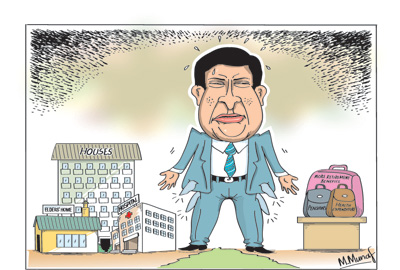Columns
Population increase poses serious economic and social challenges
View(s):The increase in Sri Lanka’s population to 25 million by 2042 and 25.8 million by 2062 poses serious economic and social challenges. Even at present with a population of 21 million the Island is one of the most densely populated countries in the world. With an increase in population to 25 million the population density would rise from 334 persons per square kilometre at present to 400 persons by mid century.
 This four million increase in population in the space of three and a half decades strains the country’s scarce financial and natural resources severely. The increasing ageing population would intensify the difficulties in coping with health issues. Caring for the increasing numbers of the elderly would require considerable resources. While the increasing ageing population poses problems, child dependency would not be reduced owing to increasing fertility.
This four million increase in population in the space of three and a half decades strains the country’s scarce financial and natural resources severely. The increasing ageing population would intensify the difficulties in coping with health issues. Caring for the increasing numbers of the elderly would require considerable resources. While the increasing ageing population poses problems, child dependency would not be reduced owing to increasing fertility.
Higher population growth
According to the latest population projection by Professor Indralal de Silva and Dr. Ranjith de Silva, the population would reach stability only in the mid 2060s at 25-26 million and not as previously expected at 23-24 million in the 2030s. This higher growth is due to recent increases in fertility from below replacement level to above replacement level.
Economic concerns
In the context of the current economic crisis, the repercussions of the demographic changes are not immediate economic concerns. Nevertheless, population ageing impacts on economic growth, savings, investment, consumption, labour markets, pensions, taxation and intergenerational transfers. Retirement benefits of corporate and government employees would be inadequate owing to the increased longevity after retirement. Furthermore retirement benefits are limited in coverage.
The care of the elderly, expansion of medical services, adequate incomes during the longer post retirement years are among the difficulties that have to be faced. Inaction in facing up to the problems would deteriorate economic and social conditions.
 Retirement benefits
Retirement benefits
The country must put in place appropriate and timely policies and institutions to deal with an ageing population. Retirement benefits should be adequate to retirees who live longer. The retirement schemes now in operation are limited in coverage, inadequate to the beneficiaries and a strain on the resources of the pension funds or the government. As life expectancy of employees increases beyond the retirement age the real value of their retirement benefits are eroded by inflation. There is a need for pension reform both in the public and private sectors, to enable adequate real incomes for extended periods of life, while at the same time being financially viable. An extension of the retirement age to 65 years would lessen financial strains on the working years and ensure more adequate retirement benefits.
Care of the elderly
Increased longevity, changing social modes of living and weakening of the traditional practice of the family caring of the elderly necessitate expanded institutional means of caring for the elderly. This could involve significant public spending, as most senior citizens would not be able to pay the full cost of such services. Besides finance, new capacities for caring for the elderly require to be developed and human resources have to be mobilised through voluntary and community participation.
Institutional capacities to care for the larger number of elderly requiring such facilities should include expansion of state facilities; increased state assistance to community and religious institutions, encouragement of community initiatives for elderly care and incentives for private-sector development of Elders’ Homes for the middle classes and the relatively affluent. A proportion of the welfare expenditure of the government should be earmarked for developing such infrastructure and assistance for the elderly.
Residential Elders’ Homes should be supplemented with day care services that are more cost-effective as well as psychologically and sociologically more satisfying as these enable elders to still live with children. Such services should include paramedical care and meals served at their own homes.
Programmes that enlist the active elderly and gives recognition for their services, could help reduce the financial burden of the programmes to cater for the elderly, as well as improve the quality of services, owing to interest and commitment in the caring of other elderly.
Reorganising medical services
The longevity of life requires greater attention to illnesses associated with old age like alzheimer’s, arthritic conditions, osteoporosis, diabetes and heart disease that would increase considerably. Geriatric services that are quite insignificant at present should be expanded.
National health policies should prioritize to meet the increasing demand for health facilities for the elderly. Medical training, specialization in geriatric care and other medical needs should be planned early. Nursing care, paramedical training and medical facilities for the elderly should receive immediate attention.
Housing
Coping with the future demand for housing is challenging. Over one hundred thousand houses are estimated to be needed annually in the next decade. The required housing stock until 2062 is of a magnitude that requires private or civil society organisations to build and upgrade houses and housing facilities. It would not be possible to meet the future demand for housing without the involvement of government.
Deforestation
The depletion of forest cover in the post independent years was no doubt a consequence of the three fold increase in population from 7 million in 1951 to 21 million today. With the expected further increase in population the forest cover would be further reduced in the future as more land would be needed to meet the demand for food production, housing, urbanisation and for development activities.
Conclusions
The new population projections pose serious challenges that must be considered in the planning of health facilities, the care of the increasing number of the elderly, social welfare, education and housing. They also have serious implications for the public finances of the country, labour force participation, retirement benefits and retirement age. It is imperative to identify and design a range of strategies to deal with the challenges faced by the ageing population. Gearing the health system to cope with the illnesses associated with old age, revamping social-security systems to generate adequate incomes for old-age sustenance and a rethinking on the methods of financing the government’s pension schemes. These are serious challenges that require the designing of appropriate policies, programmes and institutional capacities.


Leave a Reply
Post Comment